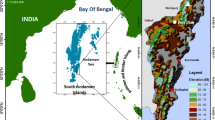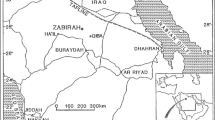Abstract
The karstification process causes mineral dissolution and mechanical removal of carbonate rocks, creating multiscale secondary porosity that greatly affects the development of karst reservoirs. The carbonate rock weathering is mainly nucleated from fractures and bedding planes and spreads out for large areas, forming a ghost-rock karst system divided by different weathering intensities. Locally, where the hydrodynamic conditions are high total removal of the weathered rock lead to the rise of the cave network and eventually the collapse or subsidence of dolines and other karst landforms. This case study presents the use of 2D and 3D GPR data to map karst levels and features in depth of a karst system in the semiarid region of NE Brazil. Synthetic GPR data and direct observation on doline crack walls support the division of karst units into ghost-rock, alterite, and residual soil zones, marked by low-amplitude reflections, and fresh to slightly weathered bedrock, indicated by vertical high-amplitude GPR zones. High-resolution aerial images and digital elevation model provide the surface geometry and distribution of karst landforms, controlled by an orthogonal weathering/fracture system identified in the GPR profiles and time slices. In addition, the karst system was vertically divided into four zones and the area of occurrence of karst units in each zone was estimated. Pore space was then calculated for each zone, assuming porosities to the filling material. We analyzed the estimated pore space distribution compared with a gas-bearing karst reservoir in China.














Similar content being viewed by others
Data availability
Geophysical data are available on request.
References
Audra P, Palmer AN (2015) Research frontiers in speleogenesis. Dominant processes, hydrogeological conditions and resulting cave patterns. Acta Carsologica 44(3):315–348
Auler AS (1999) Karst evolution and paleoclimate of eastern Brazil. PhD Dissertation, University of Bristol, UK
Beres M, Luetscher M, Olivier R (2001) Integration of ground-penetrating radar and microgravimetric methods to map shallow caves. J Appl Geophys 46:249–262
Bermejo L, Ortega AI, Parés JM, Campaña I, Castro JMB, Carbonell E, Conyers LB (2020) Karst features interpretation using ground-penetrating radar: a case study from the Sierra de Atapuerca, Spain. Geomorphology 367:107311
Borges SVF, Balsamo F, Vieira MM, Iacumin P, Srivastava NK, Storti F, Bezerra FHR (2016) Pedogenic calcretes within fracture systems and beddings in Neoproterozoic limestones of the Irecê Basin, northeastern Brazil. Sediment Geol 341:119–133
Canter KL, Stearns DB, Geesaman RC, Wilson JL (1993) Paleostructural and related paleokarst controls on reservoir development in the Lower Ordovician Ellenburger Group, Val Verde basin. In: Fritz RD, Wilson JL, Yurewicz DA (eds) Paleokarst related hydrocarbon reservoirs: SEPM Core Workshop 18, pp 61–99
Carrière SD, Chalikakis K, Sénéchal G, Danquigny C, Emblanch C (2013) Combining electrical resistivity tomography and ground penetrating radar to study geological structuring of karst unsaturated zone. J Appl Geophys 94:31–41
Cassidy NJ (2009) Electrical and magnetic properties of rocks, soils and fluids (chapter 2). In: Jol HM (ed) Ground penetrating radar theory and applications. Elsevier Science, Amsterdam, p 524
De Castro DL, Bezerra FHB, Oliveira JG (2023) Integrated geophysical approach for detection and size-geometry characterization of a multiscale karst system in carbonate units, semiarid Brazil. J Appl Geophys (submitted)
Cazarin CL, Bezerra FHR, Borghi L, Santos RV, Favoreto J, Brod JA, Auler AS, Srivastava NK (2019) The conduit-seal system of hypogene karst in Neoproterozoic carbonates in northeastern Brazil. Mar Pet Geol 101:90–107
Cheng Q, Tao M, Chen X, Binley A (2019) Evaluation of electrical resistivity tomography (ERT) for mapping the soil–rock interface in karstic environments. Environ Earth Sci 78:439
Chopra S, Marfurt KJ (2005) Seismic attributes—a historical perspective. Geophysics 70(5):3SO–28SO
Conti IMM, De Castro DL, Bezerra FHR, Cazarin CL (2019) Porosity estimation and geometric characterization of fractured and karstified carbonate rocks using GPR data in the Salitre Formation, Brazil. Pure Appl Geophys 176:1673–1689
Dembicki EA, Machel HG (1996) Recognition and delineation of paleokarst zones by the use of wireline logs in the bitumen-saturated Upper Devonian Grosmont Formation of northeastern Alberta, Canada. AAPG Bull 80:695–712
Dubois C, Quinif Y, Baele JM, Barriquand L, Bini A, Bruxelles L, Dandurand G, Havron C, Kaufmann O, Lans B, Maire R, Martin J, Rodet J, Rowberry MD, Tognini P, Vergari A (2014) The process of ghost-rock karstification and its role in the formation of cave systems. Earth Sci Rev 131:116–148
Dubois C, Deceuster J, Kaufmann O, Rowberry MD (2015) A new method to quantify carbonate rock weathering. Math Geosci 47(8):889–935
Dubois C, Goderniaux P, Deceuster J, Poulain A, Kaufmann O (2019) Hydrogeological characterization and modelling of weathered karst aquifers. Applicability to dewatering operations in limestone quarries. Environ Earth Sci 78:78–99
Ennes-Silva RA, Bezerra FHR, Nogueira FCC, Balsamo F, Klimchouk A, Cazarin CL, Auler AS (2016) Superposed folding and associated fracturing influence hypogene karst development in Neoproterozoic carbonates, São Francisco Craton, Brazil. Tectonophysics 666:244–259
Fernandes AL, Medeiros WE, Bezerra FHR, Oliveira JG, Cazarin CL (2015) GPR investigation of karst guided by comparison with outcrop and unmanned aerial vehicle imagery. J Appl Geophys 112:268–278
Ford DC, Williams PW (2007) Karst geomorphology and hydrology. Wiley, New York
Furtado CPQ, Borges SVF, Bezerra FHR, de Castro DL, Maia RP, Teixeira WLE, Souza AM, Auler AS, Lima-Filho FP (2022) The fracture-controlled carbonate Brejões Karst System mapped with UAV, LiDAR, and electroresistivity in the Irecê Basin-Brazil. J South Am Earth Sci 119:103986
Gao Q, Wang S, Peng T, Peng H, Oliver DM (2020) Evaluating the structure characteristics of epikarst at a typical peak cluster depression in Guizhou plateau area using ground penetrating radar attributes. Geomorphology 364:107015
Grasmueck M, Quintà MC, Pomar K, Eberli GP (2013) Diffraction imaging of subvertical fractures and karst with full-resolution 3D Ground-Penetrating Radar. Geophys Prospect 61:907–918
Gutiérrez F, Parise M, De Waele J, Jourde H (2014) A review on natural and human-induced geohazards and impacts in karst. Earth Sci Rev 138:61–88
He J, Fang SX, Hou FH, Yan RH, Zhao ZJ, Yao J, Tang XJ, Wu GR (2013) Vertical zonation of weathered crust ancient karst and the reservoir evaluation and prediction - A case study of M55–M51 sub-members of Majiagou Formation in gas-fields, central Ordos Basin, NW China. Petrol Explor Dev 40(1–2):524–542
Jacinto MVG, Doria Neto AD, de Castro DL, Bezerra FHR (2023) Karstified zone interpretation using deep learning algorithms: convolutional neural networks applications and model interpretability with explainable AI. Comput Geosci 171:105281
Janocha J, Smyrak-Sikora A, Senger K, Birchall T (2021) Seeing beyond the outcrop: integration of ground-penetrating radar with digital outcrop models of a paleokarst system. Mar Pet Geol 125:104833
Jiu B, Huang W, Mu N, Li Y (2021) Types and controlling factors of Ordovician paleokarst carbonate reservoirs in the southeastern Ordos Basin, China. J Petrol Sci Eng 198:108162
Kaufmann O, Deceuster J, Quinif Y (2012) An electrical resistivity imaging-based strategy to enable site-scale planning over covered palaeokarst features in the Tournaisis area (Belgium). Eng Geol 133(134):49–65
Klimchouk AB, Ford DC (2000) Types of karst and evolution of hydrogeologic settings. In: Klimchouk A, Ford DC, Palmer AN, Dreybrodt W (eds) Speleogenesis: evolution of karst aquifers. National Speleological Society, Huntsville, pp 45–53
Klimchouk A, Auler AS, Bezerra FHR, Cazarin CL, Balsamo F, Dublyansky Y (2016) Hypogenic origin, geologic controls and functional organization of a giant cave system in Precambrian carbonates, Brazil. Geomorphology 253:385–405
Lago AL, Borges WR, Barros JS, Amaral ES (2022) GPR application for the characterization of sinkholes in Teresina, Brazil. Environ Earth Sci 81(4):132 (15pp)
Liu J, Jiang Y (2018) Multiphase of the meteoric diagenetic environment of carbonates and its relationship with reservoir: a case study of the Jingxi Area in the Ordos Basin, China. Carbonates Evaporites 33:547–560
Lopes JA, Medeiros WE, Oliveira JG, Santana FL, Araújo RE, La Bruna V, Xavier MM, Bezerra FHR (2023) Three-dimensional characterization of karstic dissolution zones, fracture networks, and lithostratigraphic interfaces using GPR cubes, core logs, and petrophysics: Implications for thief zones development in carbonate reservoirs. Mar Pet Geol 150:106126
Loucks RG (1999) Paleocave carbonate reservoirs: burial-depth modifications, spatial complexity, and reservoir implications. AAPG Bull 83:1795–1834
Loucks RG, Anderson JH (1985) Depositional facies, diagenetic terrains, and porosity development in Lower Ordovician Ellenburger Dolomite, Puckett Field, west Texas. In: Roehl PO, Choquette PW (eds) Carbonate petroleum reservoirs. Springer, NewYork, pp 19–38
Martínez-Moreno FJ, Galindo-Zaldívar J, Pedrera A, Teixido T, Ruano P, Peña JA, González-Castillo L, Ruiz-Constán A, López-Chicano M, Martín-Rosales W (2014) Integrated geophysical methods for studying the karst system of Gruta de las Maravillas (Aracena, Southwest Spain). J Appl Geophys 107:149–162
Mochales T, Casas AM, Pueyo EL, Pueyo O, Román MT, Pocoví A, Soriano MA, Ansón D (2008) Detection of underground cavities by combining gravity, magnetic and ground penetrating radar surveys: a case study from the Zaragoza area, NE Spain. Environ Geol 53(5):1067–1077
Pontes CC, Bezerra FH, Bertotti G, La Bruna V, Audra P, De Waele J, Auler AS, Balsamo F, De Hoop S, Pisani L (2021) Flow pathways in multiple-direction fold hinges: implications for fractured and karstified carbonate reservoirs. J Struct Geol 146:104324
Price DG (2009) Engineering geology: principles and practice. Springer, New York
Quinif Y (2011) Ghost rock structures and the nature of Azé Caves. Quaternaire 4:7–14 (Special Issue)
Rebelo TB, Batezelli A, Mattos NHS, Leite EP (2022) Flow units in complex carbonate reservoirs: a study case of the Brazilian pre-salt. Mar Pet Geol 140:105639
Reis JA Jr, de Castro DL, Jesus TES, Lima Filho FP (2014) Characterization of collapsed paleocave systems using GPR attributes. J Appl Geophys 103:43–53
Sandmeier KJ (2022) Reflexw v. 10.0. User Manual. https://www.sandmeier-geo.de/download.html, 719 pp.
Szatmari P, Milani EJ (2016) Tectonic control of the oil-rich large igneous-carbonate-salt province of the South Atlantic rift. Mar Petrol Geol 77:567–596
Trompette R, Uhlein A, Egydio-Silva M, Karmann I (1992) The Brasiliano São Francisco craton revisited (Central Brazil). J S Am Earth Sci 6(1/2):49–57
Wang J, Zhao L, Zhang X, Yang Z, Cao H, Chen L, Shan F, Liu M (2015) Buried hill karst reservoirs and their controls on productivity. Pet Explor Dev 42(6):852–860
Zhang X, Zhu H, Lei B, Zhang J, Wang D, Yong J (2021) Sedimentary and diagenetic facies of tidal flat in epeiric sea and its related descriptive method—a case of Ma51-4 submember in Jingbian gas field of Ordos basin, China. Petroleum 7(2):123–134
Zhao W, Shen A, Qiao Z, Zheng J, Wang X (2014) Carbonate karst reservoirs of the Tarim Basin, northwest China: types, features, origins, and implications for hydrocarbon exploration. Interpretation 2(3):SF65–SF90
Acknowledgements
This research was carried out in association with the ongoing R&D project registered as ANP 20502-1, Processos e Propriedades em Reservartórios Carbonáticos Fraturados e Carstificados—POROCARSTE 3D (UFRN/UNB/UFRJ/UFC/Shell Brasil/ANP)—Porokarst—Processes and Properties in Fractured and Karstified Carbonate Reservoirs, sponsored by Shell Brasil under the ANP R&D levy as “Compromisso de Investimento com Pesquisa e Desenvolvimento”. We also thank Iuriane M. M. Conti and Francisco Tomaz Bezerra, who helped acquire and process GPR and UAV data. DLC and FHB thank the Brazilian National Council for Scientific and Technological Development (CNPq) for their productivity grants.
Funding
This study was funded by Shell Brasil under the ANP R&D levy as “Compromisso de Investimento com Pesquisa e Desenvolvimento”. Grant number: ANP 20502-1.
Author information
Authors and Affiliations
Contributions
Both authors wrote the main manuscript text, prepared the figures, and reviewed the manuscript.
Corresponding author
Ethics declarations
Competing interests
The authors declare no competing interests.
Additional information
Publisher's Note
Springer Nature remains neutral with regard to jurisdictional claims in published maps and institutional affiliations.
Rights and permissions
Springer Nature or its licensor (e.g. a society or other partner) holds exclusive rights to this article under a publishing agreement with the author(s) or other rightsholder(s); author self-archiving of the accepted manuscript version of this article is solely governed by the terms of such publishing agreement and applicable law.
About this article
Cite this article
de Castro, D.L., Bezerra, F.H.R. Characterization of a ghost-rock karst system controlled by fracture network and bedding planes in a semiarid region (NE Brazil) using ground penetrating radar (GPR). Environ Earth Sci 82, 366 (2023). https://doi.org/10.1007/s12665-023-11052-5
Received:
Accepted:
Published:
DOI: https://doi.org/10.1007/s12665-023-11052-5




